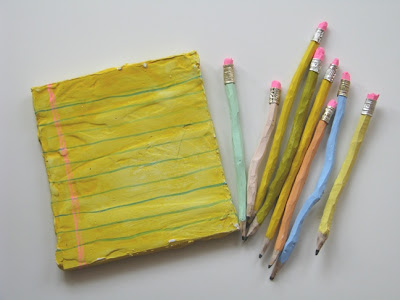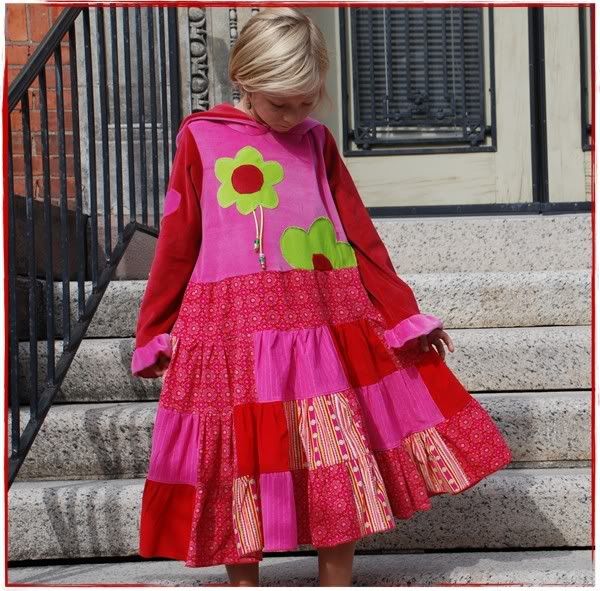The Sculpted Word
by Jon Leon 06/03/10
Ben Gocker is a New York-based artist whose exuberant drawings, paintings, sculptures, book objects, and other mixed-media works go on view next week in his first solo show at PPOW Gallery. Gocker, a librarian at the Brooklyn Public Library, curates a reading series of poetry called Poetry Time, inviting top-shelf authors to present their work in an intimate and interactive setting in a house at the border of Ridgewood, Queens and Bushwick in Brooklyn. His visual work often questions the precarious boundary where poetry alights from the page and becomes a full-blown lifestyle, an open way of moving through the world, where the graceful fold of a saddle-stitched book remains a remarkable technology.

Included in "There is really no single poem" are 11 pieces composed of small serial elements. Floating Collection consists of upwards of 30–40 books; the installation Early Poem is an assemblage of assorted collections and objects: coral, a 60-lb globe made of wood, rope, and twine, covered with canvas and horribly painted. Calendar consists of around 50 wooden staffs about 16" high whittled and painted in gouaches. These surround and interact with four boards painted and made porous with drilled out holes. Death & Friends, though one piece, is 22 separate monochromes - about the size of a hand. Drawings is an assortment of 36 plaster plates, each about the size of standard office paper. The work extends as far back as 2003 with a book called The Collected Poems of Matthew Romaine. A long scroll drawing begun about 3 years ago in Japan is an ongoing preoccupation with portability. Most of the work is very new, completed in the last 8 months or so and exhibits an all-over openness to the flux of one's surroundings.
JON LEON: I find it fascinating that you studied poetry at the University of Iowa Writers' Workshop, but instead of publishing a book of poems you're presenting your first show of drawings and sculpture and other visual works at PPOW this month. Did you ever intend to write a book, or was drawing et al, always your central discipline?
BEN GOCKER: I started out intending to write a book, and maybe I still do intend to write a book, but I feel like the work I'm doing now constitutes an approach to writing itself—not just the writing of a book, any writing at all. It seems to me that I'm still ‘on the way' to the poems. I'm creating a space for poetic practice, a poetic space—something not circumscribed by the page and yet still interested in that compositional field or place of activity. Drawing and sculpture have not always been my central discipline, yet always central to the ways in which I go about resolving the questions I have about language, life, color, and meaning—the whole experiential honeycomb.
LEON: The show's title, "There is really no single poem," is a line by the San Francisco Renaissance poet Jack Spicer. Spicer is often quoted as saying "Nobody listens to poetry." Do you find that loosening your definition of poetry allows for a more spirited and generous acknowledgment of its place among the arts? Like, if nobody listens to it, maybe they'll look at it?
GOCKER: I think it's important to keep your definitions loose. When we talk about poetry I think it's important to widen the scope rather than to narrow it. There is certainly a history of this. I'm thinking of the middle of the twentieth century here in America when poets would work collaboratively with artists, and also played roles as critics and curators. I'm thinking of O'Hara, Schuyler, Ashbery, Koch, and artists like Larry Rivers, John Cage, Robert Rauschenberg to name just a few.
There's an Ashbery poem, "And Ut Pictura Poesis Is Her Name," included in his Houseboat Days in 1977, in which he begins by writing: "You can't say it that way anymore." I think this is what artists and writers are concerned with—or can be concerned with—asking, "How can I say it?" And furthermore, how can the languages at work in different disciplines combine to make a more exacting language for getting it across—for saying it— whatever it is that has to be said. In something like 0–9, the magazine published by Vito Acconci and Bernadette Mayer in the late 60s, you have people like Dan Graham, Jasper Johns, Sol LeWitt, Hannah Weiner, Robert Smithson all seeking alternative routes to saying it - or maybe, as is the case, not saying it. But the field was open, and people had permission. Poetry has a pretty healthy history in the arts—I'm barely scraping the surface, of course— but I suppose Spicer is right somehow that no one listens to poetry. It still remains elusive.
LEON: It seems the limitations on what constitutes poetry and what the form can achieve is evolving from a hermetic and closed practice out into the world in a way that is reflexive and synergistic, almost magical, like Spicer going on about magic and transmissions in the "Poetry as Magic" workshop in 1957. There's an attention to exteriority in this shift, an acknowledgement that the work must allow entrance of a natural current from the outside, however mysterious and out-of-control it may feel, to crossover to a wider audience. What do you think about poetry's context and place in the public consciousness? Do you find it inspiring to think of it in the broader context of art generally rather than as a distinct artform?
GOCKER: A Haitian friend and I used to talk a lot about the spirit world. He had very strong opinions about this world—the reality and import of it. We would also talk about dreams being an extension of the spirit world, more accurately, the place where the spirit world and this world connect. His dreams offered him some serious and potent directives about how to live and what to do—whether it was drinking tea made from iceberg lettuce when he was sick, or taking wine at certain times of the year. Whatever it was, if someone came to him in a dream and told him to do something, he would do it. I don't know that my dreams offer me the same directives; regardless, your dreams exist, and the nightly unconscious phenomena happens. How do you choose to listen to what happens there? The same can be said of how you choose to listen to what happens anywhere at anytime during your life. What are the qualities of the world you pay attention to, in no small way, revere and allow to affect you? It's a matter of attention. When Spicer or James Merrill or an artist like Forrest Bess tap into these other possibilities of experience and relate it in their art they likewise make room for the reader or viewer of their work to apprehend more about the world.
Poetry is tough to get your head around sometimes. I think because it is made of words people want to understand it immediately, but it communicates with a rubbery immediacy. You have to give it time, and your head may never get around it. I know people who love looking at abstract art, but the minute they encounter language used with any kind of abstraction they run for the hills. I think, yes, if poetry can be approached from within the larger context of art people may allow themselves to listen.
LEON: You speculate on the qualities of the world we allow to affect us. Is there a diffusion of social stimuli that affects how you create and perceive your work? I'm thinking of the collection of monochromes titled Death & Friends (2010). Your work appears to be just delicate and reverent enough in its lightness of color, and its motivation to include the emotional and physical detritus of a world outside it to be impressionable in a meaningful way. It's generous to the space it occupies in the world by allowing the viewer entrance to it, like the delight that comes with a close reading of a text.
GOCKER: There's a lot out there that influences me. The work reflects those influences, reorders them, and presents them in another fashion. Death & Friends is a piece that points away from itself and toward another piece in the show, a large disc entitled Names, where I've written out in paint the names of acquaintances and friends and coworkers and old lovers; which in turn points to the 1970 Jon Anderson book of poems from which the title derives; which leads to Yves Klein's Yves Peintures and Haguenault Peintures. In some way, though the piece is drawing on all of these other sources, it can still be an empty space where someone can enter and think and look; and as you alluded to, approach the work with the sensibility of performing a close textual reading. I'd like the works to be simultaneously full and empty, to draw and to point, and ultimately, yes, to be generous













0 comments:
Post a Comment